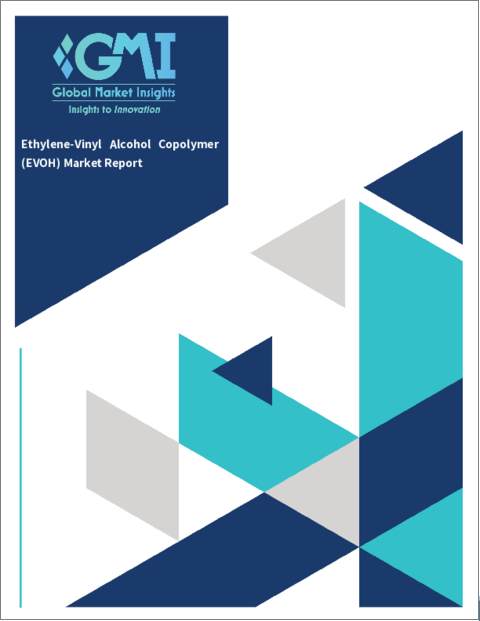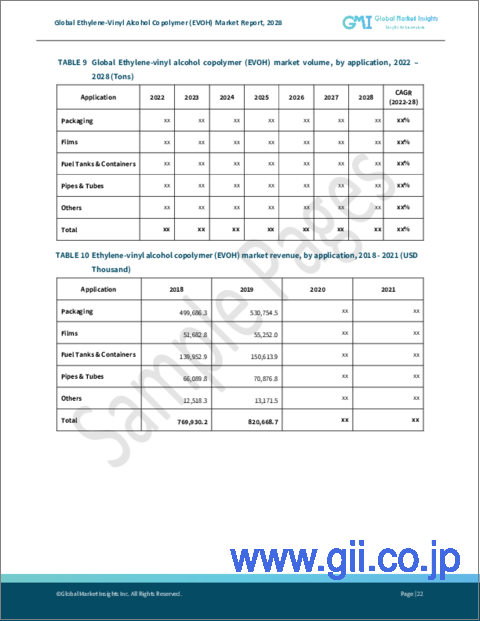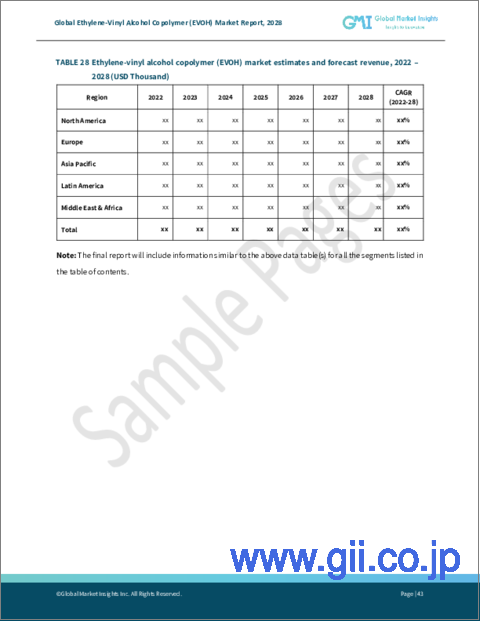|
|
市場調査レポート
商品コード
1088271
エチレンビニルアルコール共重合体 (EVOH) の世界市場 (2022-2028年):市場規模 (グレード・用途・エンドユーザー産業別)・地域的展望・成長の潜在性・価格動向・市場シェア・予測Ethylene-vinyl Alcohol Copolymer Market By Grade, By Application, By End-use Industry, Regional Outlook, Growth Potential, Price Trends, Competitive Market Share & Forecast, 2022-2028 |
||||||
|
● お客様のご希望に応じて、既存データの加工や未掲載情報(例:国別セグメント)の追加などの対応が可能です。 詳細はお問い合わせください。 |
|||||||
| エチレンビニルアルコール共重合体 (EVOH) の世界市場 (2022-2028年):市場規模 (グレード・用途・エンドユーザー産業別)・地域的展望・成長の潜在性・価格動向・市場シェア・予測 |
|
出版日: 2022年06月07日
発行: Global Market Insights Inc.
ページ情報: 英文 300 Pages
納期: 2~3営業日
|
- 全表示
- 概要
- 目次
エチレンビニルアルコール共重合体 (EVOH) の市場は、世界で包装食品・飲料製品の需要が拡大していることから、2028年にかけて大幅に成長すると予測されています。
また、製品を外部の汚染物質から保護するための効率的なソリューションが注目されていることも予測期間中のEVOHの普及を後押しするものと考えられています。
用途別で見ると、パイプ&チューブの部門が予測期間中5.6%超のCAGRで成長すると予測されています。また、エンドユーザー産業別では、食品・飲料の部門が2021年に55%を超えるシェアを示しています。一方、成長率では、自動車部門が予測期間中約6.2%のCAGRを示すと予測されています。
当レポートでは、世界のエチレンビニルアルコール共重合体 (EVOH) の市場を調査し、市場の定義と概要、市場成長への各種影響因子の分析、法規制環境、特許動向、市場規模の推移・予測、各種区分・地域/主要国別の内訳、競合環境、主要企業のプロファイルなどをまとめています。
目次
第1章 調査手法・調査範囲
第2章 エグゼクティブサマリー
第3章 産業の考察
- 産業情勢
- 産業のエコシステム分析
- 規制状況
- 特許分析
- 産業への影響要因
- 成長要因
- 産業の潜在的リスク&課題
- 価格分析
- メーカー別の生産能力
- 成長の可能性の分析
- ポーターの分析
- PESTLE分析
第4章 競合情勢
- 企業の市場シェア
- 主要企業の競合分析
- 戦略ダッシュボード
第5章 エチレンビニルアルコール共重合体 (EVOH) 市場:グレード別
- 市場シェア
- 標準グレード
- 特殊グレード
第6章 エチレンビニルアルコール共重合体 (EVOH) 市場:用途別
- 市場シェア
- 包装材
- フィルム
- 燃料タンク&コンテナ
- パイプ&チューブ
- その他
第7章 エチレンビニルアルコール共重合体 (EVOH) 市場:エンドユーザー産業別
- 市場シェア
- 食品・飲料
- 農業
- 自動車
- 化粧品
- 医薬品
- 建設
- その他
第8章 エチレンビニルアルコール共重合体 (EVOH) 市場:地域別
- 市場シェア
- 北米
- 欧州
- アジア太平洋
- ラテンアメリカ
- 中東・アフリカ
The ethylene-vinyl alcohol copolymer (EVOH) market is set to expand significantly by 2028 due to the growing demand for packaged food & beverage products across the globe. In addition, mounting prominence of efficient solutions to protect products against external contaminants is likely to boost the uptake of EVOH in the forecast period.
The ethylene-vinyl alcohol copolymer is made of ethylene alcohol and vinyl alcohol with significant properties, such as effectiveness in restricting gases, longer shelf life, no to low preservatives requirement, and improved product attractiveness. The COVID-19 pandemic positively influenced the EVOH industry due to a rise in demand for packaged food attributed to changes in lifestyle and stringent lockdowns.
However, relaxations in lockdowns and increasing focus of key participants on expanding production capacity in line with effective growth strategies have boosted ethylene-vinyl alcohol copolymer (EVOH) market growth. For instance, in August 2021, Kuraray, a chemical manufacturing company, introduced EVAL SC, a novel grade of its EVAL gas barrier resin range that delivers better shrinkability and stretchability. The product supports biaxially-inclined multilayer films for food packaging use, consisting of shrink bags and skin packaging materials.
Furthermore, in March 2022, Kuraray joined hands with the 4evergreen alliance, a cross-industry packaging alliance, to produce circular concepts, particularly for fiber-based packaging. The 4evergreen alliance is working toward raising the recycling rate of fiber-based packaging to 90% in Europe by 2030. By joining the alliance, Kuraray agreed to contribute its experience, such as for developing uniform Europe-wide recycling standards.
The ethylene-vinyl alcohol copolymer (EVOH) market has been bifurcated based on end-use, grade, application, and region.
In terms of application, the industry has been further divided into films, fuel tanks and containers, packaging, pipes & tubes, and others. The pipes & tubes application segment is projected to grow at more than 5.6% CAGR over the assessment period. Moreover, the others application segment is expected to expand at a CAGR of around 3.5% through the review timeline.
With regards to end-use, the EVOH industry has been categorized into construction, agricultural, food & beverages, automotive, pharmaceuticals, cosmetics, and others. In 2021, the food & beverages segment registered over 55% market share. Meanwhile, the automotive segment is anticipated to grow at a CAGR of around 6.2% through the study timeframe. The construction segment is speculated to grow at approximately 6.1% CAGR over the review timeline.
In the regional landscape, the ethylene-vinyl alcohol copolymer (EVOH) market in Latin America is set to exhibit strong growth at around 6.0% CAGR through the forecast period. On the other hand, rising demand for food & beverage products is likely to accelerate the development of the EVOH market in the Middle East & Africa region.
Table of Contents
Chapter 1 Methodology and Scope
- 1.1 Scope & definitions
- 1.2 Methodology and forecast parameters
- 1.3 Region-wise COVID-19 impact:
- 1.3.1 North America
- 1.3.2 Europe
- 1.3.3 Asia Pacific
- 1.3.4 Latin America
- 1.3.5 Middle East & Africa
- 1.4 Regional trends
- 1.5 Data sources
- 1.5.1 Secondary
- 1.5.2 Primary
Chapter 2 Executive Summary
- 2.1 Ethylene-vinyl alcohol copolymer (EVOH) industry 360 degree synopsis, 2018 - 2028
- 2.1.1 Business trends
- 2.1.2 Grade trends
- 2.1.3 Application trends
- 2.1.4 End-use industry trends
- 2.1.5 Regional trends
Chapter 3 Ethylene-Vinyl Alcohol Copolymer (EVOH) Industry Insights
- 3.1 Introduction
- 3.2 Industry landscape, 2018 - 2028
- 3.2.1 Impact analysis of coronavirus COVID-19 pandemic
- 3.3 Industry ecosystem analysis
- 3.3.1 Raw material trends
- 3.3.2 Manufacturing trends
- 3.3.3 Profit margin trends
- 3.3.4 Distribution channel analysis
- 3.3.5 Value chain disruption analysis (COVID-19 impact)
- 3.3.6 Vendor matrix
- 3.4 Regulatory landscape
- 3.4.1 U.S.
- 3.4.2 Europe
- 3.4.3 Asia Pacific
- 3.5 Patent analysis
- 3.6 Industry impact forces
- 3.6.1 Growth drivers
- 3.6.1.1 Growing demand for flexible packaging
- 3.6.1.2 Rising demand for EVOH in the food & beverage industry
- 3.6.2 Industry pitfalls and challenges
- 3.6.2.1 Poor adhesion characteristics of EVOH resins
- 3.6.1 Growth drivers
- 3.7 Pricing analysis
- 3.7.1 Regional price trends
- 3.7.2 Cost structure analysis
- 3.7.2.1 R&D cost
- 3.7.2.2 Manufacturing & equipment cost
- 3.7.2.3 Raw material cost
- 3.7.2.4 Distribution cost
- 3.7.2.5 Operating cost
- 3.7.2.6 Miscellaneous cost
- 3.7.3 COVID-19 impact on pricing
- 3.8 Production capacities by manufacturers
- 3.9 Growth potential analysis
- 3.10 Porter's analysis
- 3.10.1 Supplier power
- 3.10.2 Buyer power
- 3.10.3 Threat of new entrants
- 3.10.4 Threat of substitutes
- 3.10.5 Industry rivalry
- 3.11 PESTLE analysis
Chapter 4 Competitive Landscape, 2021
- 4.1 Introduction
- 4.1.1 Company market share, 2021
- 4.1.2 Competitive analysis of major market players, 2021
- 4.1.3 Strategy dashboard
Chapter 5 Ethylene-Vinyl Alcohol Copolymer (EVOH) Market, By Grade
- 5.1 Ethylene-vinyl alcohol copolymer (EVOH) market share, by grade, 2021 & 2028
- 5.2 Standard grade
- 5.2.1 Global Market estimates and forecast, 2018 - 2028
- 5.2.2 Market estimates and forecast, by region, 2018 - 2028
- 5.3 Specialty grade
- 5.3.1 Global Market estimates and forecast, 2018 - 2028
- 5.3.2 Market estimates and forecast, by region, 2018 - 2028
Chapter 6 Ethylene-Vinyl Alcohol Copolymer (EVOH) Market, By Application
- 6.1 Ethylene-vinyl alcohol copolymer (EVOH) market share, by application, 2021 & 2028
- 6.2 Packaging
- 6.2.1 Global Market estimates and forecast, 2018 - 2028
- 6.2.2 Market estimates and forecast, by region, 2018 - 2028
- 6.3 Films
- 6.3.1 Global Market estimates and forecast, 2018 - 2028
- 6.3.2 Market estimates and forecast, by region, 2018 - 2028
- 6.4 Fuel Tanks & Containers
- 6.4.1 Global Market estimates and forecast, 2018 - 2028
- 6.4.2 Market estimates and forecast, by region, 2018 - 2028
- 6.5 Pipes & Tubes
- 6.5.1 Global Market estimates and forecast, 2018 - 2028
- 6.5.2 Market estimates and forecast, by region, 2018 - 2028
- 6.6 Other applications
- 6.6.1 Global Market estimates and forecast, 2018 - 2028
- 6.6.2 Market estimates and forecast, by region, 2018 - 2028
Chapter 7 Ethylene-Vinyl Alcohol Copolymer (EVOH) Market, By End-Use
- 7.1 Ethylene-vinyl alcohol copolymer (EVOH) market share, by end-use, 2021 & 2028
- 7.2 Food & beverages
- 7.2.1 Global Market estimates and forecast, 2018 - 2028
- 7.2.2 Market estimates and forecast, by region, 2018 - 2028
- 7.3 Agricultural
- 7.3.1 Global Market estimates and forecast, 2018 - 2028
- 7.3.2 Market estimates and forecast, by region, 2018 - 2028
- 7.4 Automotive
- 7.4.1 Global Market estimates and forecast, 2018 - 2028
- 7.4.2 Market estimates and forecast, by region, 2018 - 2028
- 7.5 Cosmetics
- 7.5.1 Global Market estimates and forecast, 2018 - 2028
- 7.5.2 Market estimates and forecast, by region, 2018 - 2028
- 7.6 Pharmaceuticals
- 7.6.1 Global Market estimates and forecast, 2018 - 2028
- 7.6.2 Market estimates and forecast, by region, 2018 - 2028
- 7.7 Construction
- 7.7.1 Global Market estimates and forecast, 2018 - 2028
- 7.7.2 Market estimates and forecast, by region, 2018 - 2028
- 7.8 Others
- 7.8.1 Global Market estimates and forecast, 2018 - 2028
- 7.8.2 Market estimates and forecast, by region, 2018 - 2028
Chapter 8 Ethylene-Vinyl Alcohol Copolymer (EVOH) Market, By Region
- 8.1 Ethylene-vinyl alcohol copolymer (EVOH) market share, by region, 2021 & 2028
- 8.2 North America
- 8.2.1 Market estimates and forecast, 2018 - 2028
- 8.2.2 Market estimates and forecast, by grade, 2018 - 2028
- 8.2.3 Market estimates and forecast, by application, 2018 - 2028
- 8.2.4 Market estimates and forecast, by end-use, 2018 - 2028
- 8.2.5 U.S.
- 8.2.5.1 Market estimates and forecast, 2018 - 2028
- 8.2.5.2 Market estimates and forecast, by grade, 2018 - 2028
- 8.2.5.3 Market estimates and forecast, by application, 2018 - 2028
- 8.2.5.4 Market estimates and forecast, by end-use, 2018 - 2028
- 8.2.6 Canada
- 8.2.6.1 Market estimates and forecast, 2018 - 2028
- 8.2.6.2 Market estimates and forecast, by grade, 2018 - 2028
- 8.2.6.3 Market estimates and forecast, by application, 2018 - 2028
- 8.2.6.4 Market estimates and forecast, by end-use, 2018 - 2028
- 8.3 Europe
- 8.3.1 Market estimates and forecast, 2018 - 2028
- 8.3.2 Market estimates and forecast, by grade, 2018 - 2028
- 8.3.3 Market estimates and forecast, by application, 2018 - 2028
- 8.3.4 Market estimates and forecast, by end-use, 2018 - 2028
- 8.3.5 Germany
- 8.3.5.1 Market estimates and forecast, 2018 - 2028
- 8.3.5.2 Market estimates and forecast, by grade, 2018 - 2028
- 8.3.5.3 Market estimates and forecast, by application, 2018 - 2028
- 8.3.5.4 Market estimates and forecast, by end-use, 2018 - 2028
- 8.3.6 UK
- 8.3.6.1 Market estimates and forecast, 2018 - 2028
- 8.3.6.2 Market estimates and forecast, by grade, 2018 - 2028
- 8.3.6.3 Market estimates and forecast, by application, 2018 - 2028
- 8.3.6.4 Market estimates and forecast, by end-use, 2018 - 2028
- 8.3.7 France
- 8.3.7.1 Market estimates and forecast, 2018 - 2028
- 8.3.7.2 Market estimates and forecast, by grade, 2018 - 2028
- 8.3.7.3 Market estimates and forecast, by application, 2018 - 2028
- 8.3.7.4 Market estimates and forecast, by end-use, 2018 - 2028
- 8.3.8 Spain
- 8.3.8.1 Market estimates and forecast, 2018 - 2028
- 8.3.8.2 Market estimates and forecast, by grade, 2018 - 2028
- 8.3.8.3 Market estimates and forecast, by application, 2018 - 2028
- 8.3.8.4 Market estimates and forecast, by end-use, 2018 - 2028
- 8.3.9 Italy
- 8.3.9.1 Market estimates and forecast, 2018 - 2028
- 8.3.9.2 Market estimates and forecast, by grade, 2018 - 2028
- 8.3.9.3 Market estimates and forecast, by application, 2018 - 2028
- 8.3.9.4 Market estimates and forecast, by end-use, 2018 - 2028
- 8.3.10 Russia
- 8.3.10.1 Market estimates and forecast, 2018 - 2028
- 8.3.10.2 Market estimates and forecast, by grade, 2018 - 2028
- 8.3.10.3 Market estimates and forecast, by application, 2018 - 2028
- 8.3.10.4 Market estimates and forecast, by end-use, 2018 - 2028
- 8.4 Asia Pacific
- 8.4.1 Market estimates and forecast, 2018 - 2028
- 8.4.2 Market estimates and forecast, by grade, 2018 - 2028
- 8.4.3 Market estimates and forecast, by application, 2018 - 2028
- 8.4.4 Market estimates and forecast, by end-use, 2018 - 2028
- 8.4.5 China
- 8.4.5.1 Market estimates and forecast, 2018 - 2028
- 8.4.5.2 Market estimates and forecast, by grade, 2018 - 2028
- 8.4.5.3 Market estimates and forecast, by application, 2018 - 2028
- 8.4.5.4 Market estimates and forecast, by end-use, 2018 - 2028
- 8.4.6 India
- 8.4.6.1 Market estimates and forecast, 2018 - 2028
- 8.4.6.2 Market estimates and forecast, by grade, 2018 - 2028
- 8.4.6.3 Market estimates and forecast, by application, 2018 - 2028
- 8.4.6.4 Market estimates and forecast, by end-use, 2018 - 2028
- 8.4.7 Japan
- 8.4.7.1 Market estimates and forecast, 2018 - 2028
- 8.4.7.2 Market estimates and forecast, by grade, 2018 - 2028
- 8.4.7.3 Market estimates and forecast, by application, 2018 - 2028
- 8.4.7.4 Market estimates and forecast, by end-use, 2018 - 2028
- 8.4.8 Australia
- 8.4.8.1 Market estimates and forecast, 2018 - 2028
- 8.4.8.2 Market estimates and forecast, by grade, 2018 - 2028
- 8.4.8.3 Market estimates and forecast, by application, 2018 - 2028
- 8.4.8.4 Market estimates and forecast, by end-use, 2018 - 2028
- 8.4.9 Indonesia
- 8.4.9.1 Market estimates and forecast, 2018 - 2028
- 8.4.9.2 Market estimates and forecast, by grade, 2018 - 2028
- 8.4.9.3 Market estimates and forecast, by application, 2018 - 2028
- 8.4.9.4 Market estimates and forecast, by end-use, 2018 - 2028
- 8.4.10 South Korea
- 8.4.10.1 Market estimates and forecast, 2018 - 2028
- 8.4.10.2 Market estimates and forecast, by grade, 2018 - 2028
- 8.4.10.3 Market estimates and forecast, by application, 2018 - 2028
- 8.4.10.4 Market estimates and forecast, by end-use, 2018 - 2028
- 8.5 Latin America
- 8.5.1 Market estimates and forecast, 2018 - 2028
- 8.5.2 Market estimates and forecast, by grade, 2018 - 2028
- 8.5.3 Market estimates and forecast, by application, 2018 - 2028
- 8.5.4 Market estimates and forecast, by end-use, 2018 - 2028
- 8.5.5 Brazil
- 8.5.5.1 Market estimates and forecast, 2018 - 2028
- 8.5.5.2 Market estimates and forecast, by grade, 2018 - 2028
- 8.5.5.3 Market estimates and forecast, by application, 2018 - 2028
- 8.5.5.4 Market estimates and forecast, by end-use, 2018 - 2028
- 8.5.6 Mexico
- 8.5.6.1 Market estimates and forecast, 2018 - 2028
- 8.5.6.2 Market estimates and forecast, by grade, 2018 - 2028
- 8.5.6.3 Market estimates and forecast, by application, 2018 - 2028
- 8.5.6.4 Market estimates and forecast, by end-use, 2018 - 2028
- 8.6 Middle East & Africa
- 8.6.1 Market estimates and forecast, 2018 - 2028
- 8.6.2 Market estimates and forecast, by grade, 2018 - 2028
- 8.6.3 Market estimates and forecast, by application, 2018 - 2028
- 8.6.4 Market estimates and forecast, by end-use, 2018 - 2028
- 8.6.5 South Africa
- 8.6.5.1 Market estimates and forecast, 2018 - 2028
- 8.6.5.2 Market estimates and forecast, by grade, 2018 - 2028
- 8.6.5.3 Market estimates and forecast, by application, 2018 - 2028
- 8.6.5.4 Market estimates and forecast, by end-use, 2018 - 2028
- 8.6.6 Saudi Arabia
- 8.6.6.1 Market estimates and forecast, 2018 - 2028
- 8.6.6.2 Market estimates and forecast, by grade, 2018 - 2028
- 8.6.6.3 Market estimates and forecast, by application, 2018 - 2028
- 8.6.6.4 Market estimates and forecast, by end-use, 2018 - 2028
- 8.6.7 UAE
- 8.6.7.1 Market estimates and forecast, 2018 - 2028
- 8.6.7.2 Market estimates and forecast, by grade, 2018 - 2028
- 8.6.7.3 Market estimates and forecast, by application, 2018 - 2028
- 8.6.7.4 Market estimates and forecast, by end-use, 2018 - 2028




